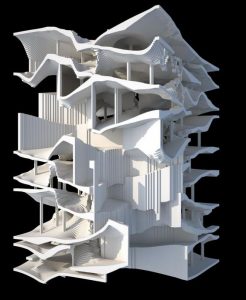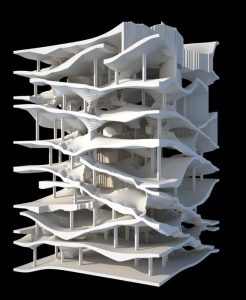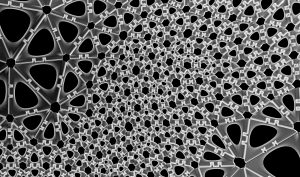Alka Cappellazzo is an artist and creative coder whose body of work seems to center around code-based animations. She doesn’t have a website, or any interviews and it was generally pretty difficult to find information regarding her. In a way she seems like the type of artist who likes to step out of the spotlight and let her work take center-stage for those who are interested in it. From what I was able to find however, I can say that she is currently based out of Italy and graduated from the Brera Academy of Fine Arts with degrees in New Art Technologies and Network Medias. She is also the current vice-president and co-founder of Invalid Code – an Italy based collective of “artists and programmers born to explore and spread the potential of the code.”
I want to take the time to talk about a body of work of hers, as opposed to an individual work, the series is called White Transparency and consists of a variety of animations or static images which are repetitions of graphics creating an ornamental and visually intriguing design. These patterns cleanly represent her interest in exploring the repetition of images and patterns in nature through the medium of code. Using Processing to facilitate these designs, she frequently codes these patterns while including random and noise functions so as to get some real/interesting or unexpected designs, similar to the unpredictability that nature holds with code. She also makes sure to make the code available to the audience, as she believes that code is something to be shared and expanded upon instead of huddled away and to be jealous of.
Below I am including some links to the processing pieces in addition to screenshots because I believe they are better experienced in real-time than seen in a still image.
White Transparency IV Link https://www.openprocessing.org/sketch/187998/embed/?width640&height=480&border=true


White Transparency II Link https://www.openprocessing.org/sketch/173726/embed/?width=640&height=480&border=true
]]>

Oblique Circulation 3
My eyes were immediately drawn to this image when I opened Pinterest. I’m an architecture student and this computer-generated building looks almost magical to me. As an architectural student I need to think about how to divide up space when I design. Using algorithm to do the work might not be the most functional solution but the result is definitely interesting. The artists tries to show circulation around the building through computer-generated curves. I didn’t find what algorithm the artist used but this reminds me of Grasshopper, a plug-in for Rhino that architect students often uses. Grasshopper is designed for parametric modeling. Using grasshopper to generate geometries is like using grasshopper’s language to tell it to do certain things.
The artist is Benjamin Dillenburger and the work title is Oblique Circulation 3. You can see more of his work here.
Reverberating Across the Divide: Digital Design Meets Physical Context from Madeline Gannon on Vimeo.
I looked at the project “Reverberating Across the Divide” by Madeline Gannon. I thought it was really interesting because it took a thorough route of combining digital and physical input and output. This was my first time being exposed to the topic of a chronomorphologic modeling environment. I’m especially impressed with the complexity of technology that is now possible in order for the designer to have been able to scan and create forms virtually, taking influence and depth from the real world. “A depth camera translates a physical space or object into a three-dimensional point cloud,” which allows her to create the expressive, exoskeleton-like forms that have strong influence from both the digital scans and physical features. I am a product design student, so I know a bit about 3D printing- but I didn’t know about the possibilities of scanning a physical form and then altering it in virtual reality. It excites me to think that if these technologies are possible for this whimsical project that created interesting, decoration-like forms, advancements in other areas like treating broken bones can also be made; I heard about 3D printing casts a few years ago, so I’m sure the tech has become more efficient since then.
]]>

According to the artist Sui Park, SPUME presents “soft flows of evolving sentiment.” This gives a feeling of flow, and the artist herself likens her art to emotions and sentiments, which are not static.
The algorithms to create her art looks as if they are built upon each and every additional “stitch” or piece to make up a whole. Although, it is not specified what algorithm was used exactly.
This reminds me that in all the projects I do in the future, it is always important to remember which message I want to convey to all those who view it. Instead of always just worrying about the technical and aesthetic aspect of the art I am producing, I feel that the inside main message that the art is conveying is equally important. Although her art is technically static, it looks to be continuously flowing.
]]>Project: Iris Van Herpen’s line of laser-cut/3d-printed dresses
http://www.additivefashion.com/wp-content/uploads/2013/05/RadiationSS10-418B.jpg
Iris van Herpen “Radiation Invasion” Sept 2009 Leather
I really admire this project because it really combines hand craftsmanship with the precision and automation of modern digital methods. Even though she used digital tools to cut the materials, she still had to use her aesthetic sensibilities to come up with the patterns and designs. In addition, I assume in assembling the dress, she still had to do it by hand to fit the dress to the specific model. It also inspired me in how she worked with various different manufacturers and partners in order to create the necessary forms.
I visited her exhibit at the Carnegie Museum last year, and in the exhibit, she talked about how many people told her that her vision could not be accomplished with existing technology. I love that her vision was so strong that she was so insistent in bringing her creations to live.
]]>
I really enjoyed the computational art of Andy Lomas which was referenced in Prof. Levin’s article. The logic governing his algorithm was very well described, providing a useful insight into the methods of generative art. Lomas’s patterns are created by simulating a series of virtual cells which accumulate “nutrients” based on various factors, allowing them to multiply. He notes that many of the simulations were accidentally reminiscent of various forms of life, often based on intuitive factors (such as the directional growth of plant-like simulations). While this was touted as demonstrating the capability of algorithms to approximate organisms, I found it to be a reminder that life itself is merely algorithmic.
]]>This project is called the “Silk Pavillion”.
It was constructed, frame wise, with a CNC mill, and then spun using a threading device based off an algorithm. I don’t know the algorithm type that generated the organization of the thread, but I do know it’s designed to create an even spread and to form even, circular holes in the structure of each frame.
I think this is an incredible use of parametric design because it uses an extremely nature-based construction process. The designers used 6500 silkworms to construct the finer layer of the pavilion and created something incredible.
I think the artist’s sensibilities were based off two things: The algorithm, and nature. Neither can be fully predicted with the human mind and so the artist understood fully that the final product would be completely unpredictable to every fine detail. He did understand the type of structure that would result, as well as the texture and feel it would create because he still designed the overall structure.
I think sometimes, parametric design lacks a natural, human element to it, but this project incorporated nature in such a direct way that it avoided that common pitfall.
]]>

This project, Rocailles, done by Benjamin Dillenburger, struck me for its illusion of almost fabric-like texture. The way the material folds and falls reminds me of an afghan bunched up, perhaps hanging from some sort of wire or string. At the same time, though, it also gives the sense of a hard, shell like texture, through its sharp lines and crystalline weaving. These textures are at a sharp contrast to one another, and thus give an interesting affect to the viewer.
The number of folds, as well as depth in relation to the viewer, give this piece quite a bit of emotional impact — casting powerful shadows and fading in towards the center. Paired with the folds and the sense of gravity they give the piece, it feels like you are being pulled towards the center darkness. This sort of material affect would be hard to accomplish by any other means.
I think the Dillenburger used an algorithm to create a sort of “stitching”, that look like N’s aligned in rows lined by one long piece of elastic material. Then, by using a great number of parameters, he probably slightly shifted on of the lines in the N, or the angle between them, to pull and push the entire sculpture into its desired shape.
To look at more close up images of Rocailles, check out this page: http://benjamin-dillenburger.com/rocaille/
]]>
3D Print Gown by Michael Schmidt and Francis Bitonti, 2013

This is the first fully 3D printed gown in the world. This gown is designed by Michael Schmidt and 3D modeled by Francis Bitonti. Michael Schmidt was inspired by the well-known Fibonacci Golden Ratio Sequence which mathematically measures the ratio to create the ideals of beauty. It has been proven in many cases, especially in nature. He applied this golden ratio of beauty to create a beautiful and sensual form of a gown. This gown was 3D printed in Nylon and consists of 17 pieces that can be assembled. Its customized design made a perfect fit to a model’s body.
In my opinion, this project displays the future of clothing. It could be the very beginning step of the way manufacture garments in our future. So, if clothing can be printed, there would be more variety of design methods and customized to make a perfect fit for specific customers. I really admire their effort and attempt to create clothes in 3D print that could be a future method to produce our clothes, and also still to keep aesthetic aspects of clothing.
]]>
My first encounter with Madeline Gannon’s project helped me think about things from another perspective. Can this organic and hand-made like wearable decoration be made by computational digital fabrication? Watching Gannon’s video, I was attracted by this combination. Exploring even deeper, I found many similar ideas where digital fabrication and computational algorithms are used to produce wearable and fashionable objects. One project that I really like is the “Kinematics Dress” by Nervous System. Jessica Rosenkrantz and Jesse Louis-Rosenberg, which is also called as “Nervous System”, have been doing highly influential work in the computational design of constructing decorative objects and garments.
The Kinematics Dress is a technical achievement made by a 3D-printed garment to satisfy people’s needs of wearing a dress made out of current technology that is comfortable and durable. The Kinematics Dress is fabricated in nylon by 3D printing with Selection Laser Sintering. The first idea of the project is to make a necklace where the necklace is printed flat and can be folded later. The object will be made in computer code relating to kinematics algorithms first and then printed in a 3D printer.

The Nervous System intends the move from assembling all little pieces and construct a larger piece to making a smart material that will self-assemble itself. They start with computational folding and simulation to construct the dress in one piece. They then create a large object of a 3d scanned person that is larger than the 3d printer and then fold to suit the fabrication. Then, when taking out of the machine, the dress gets unfold. The final presentation of the dress is hard material connected with softer connections where they link with each other and can move freely. I really admire this project as it combines engineering and science with design and fabrication. It presents me with a bigger idea that opens up more possibilities to create garments with today’s technology.

